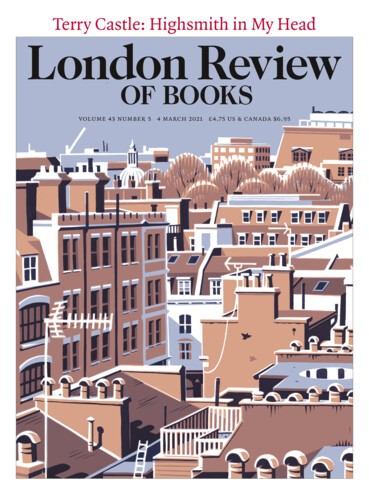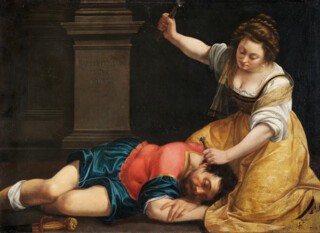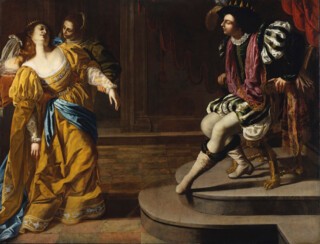Light falls on the side of a woman’s upturned face, travels over her right shoulder and forearm and then down to her thigh and knee. The limbs are dense and opaque, the solid curve of the upper arm mirroring the heavy bent leg with its bluish shadows of muscle. The flesh is massive but yielding: the woman’s left breast bulges and puckers like real tissue as she grasps it between the fingers of one hand. The composition is closely cropped and the body truncated, so that its shape fills the frame and swallows up the pitch-dark ground. This is Lucretia, depicted by Artemisia Gentileschi at the moment before she kills herself following her violation by Tarquin: not the uncertain-looking, girlish Lucretia portrayed by Artemisia’s colleague Simon Vouet, nor Guido Reni’s grave classical beauty with one hand casually resting on the dagger, but a mature woman with a substantial physical presence, capable and gripped by determination. She looks as if she’s really going to do it.
The National Gallery’s Artemisia exhibition, which was open until the latest lockdown and is available online, is full of images of capability. It mattered to Artemisia that painted narratives were believable, that depicted characters seemed equal to the demanding situations in which they found themselves. Her father, Orazio Gentileschi, an established history painter who trained her at home in Rome, was as much concerned with compositional elegance as believability: in his Saint Michael and the Devil (1607), the saint props his knee on candyfloss clouds so delicate it’s hard to imagine them taking his weight. Artemisia’s Allegory of Inclination (1615-16), by contrast, part of a decorative ceiling in Florence commissioned by Michelangelo’s great-nephew, makes sitting upright on a bank of clouds look plausible, even comfortable. Her nude female bodies take the temperature of their environment. In the early Susannah and the Elders (1610), the detail of Susannah’s bare feet – tinged red with cold, hastily withdrawn from the fountain where she’s been bathing – lends credibility to the twisted symmetry of her body, turning a posed form into responsive flesh.
Artemisia’s history paintings describe the way heroic actions are accomplished at the same time as showing them happening. Her earliest treatment of Judith Beheading Holofernes (c.1612-13) retains the broad compositional arrangement of Caravaggio’s gruesome depiction (c.1599) while altering important details. Judith’s arms cut across the picture in severe parallel lines, as she grasps Holofernes by the hair and runs her sword through his neck. But she approaches her first decapitation awkwardly, driving the blade away from her body rather than pulling it towards her, so Artemisia has her half-straddle the bed for stability, her knee wedged into her victim’s side. Her maidservant Abra, relegated to the sidelines in Caravaggio’s version, rolls up her sleeves and leans in from behind, pinning Holofernes down as he struggles to escape. The weaponry involved looks hefty and real. In Judith and Her Maidservant (c.1614-15), Artemisia’s third treatment of the Judith story, the stolen sword – viciously sharp, capped with a decorative pommel – rests on the heroine’s shoulder to balance out its weight; while in Jael and Sisera (1620), the tent peg Jael prepares to hammer into her enemy’s skull is unpleasantly thick.
In the early 17th-century theatre, plays about Judith and Holofernes tended not to show the moment of decapitation, leaving audiences to imagine it. Artemisia, who received her cultural education from a fashionable circle of dramatists, musicians and performing poets at the Medici court, was interested in what painting could learn from dramatic convention, the question of what could be performed and what had to be visualised offstage. She often took an oblique approach, skirting around the traditional centres of narratives. Cleopatra (c.1633-35) is remarkable for showing the queen already dead, her body drained and greyish, the asp uncoiled beside her on the bed. Esther before Ahasuerus (c.1628-30) is pure theatre, depicting the Persian king anachronistically decked out in full commedia dell’arte costume and framed by a red stage curtain; the fainting Esther is washed out not only by her days of fasting but also by the riot of colour that surrounds her. A similar stage curtain appears in Judith and Her Maidservant with the Head of Holofernes (c.1623-35), in which Artemisia depicts the hushed moment at which Judith and Abra, having snuck into Holofernes’ tent to kill him, are startled by a sound as they prepare to flee the encampment. Flickering candlelight throws their profiles into relief as they peer out into the darkness stage right; any hostile approach we might imagine takes place beyond our view, in the wings. In this world, the props of the artist’s studio become theatre props, and the gold-fringed curtain fabric becomes eerily self-referential, recalling its use ten years earlier to represent a velvet throw on Holofernes’ bed.
Artemisia, who understood – and relied on – the fact that male collectors were liable to see her face and body behind each Judith, Cleopatra or Susannah, was no stranger to playing parts. Live models were expensive and couldn’t always be relied on to look right for the role; using her own features made good financial sense and had the added advantage of enhancing her personal fame, turning her pictures into instruments of celebrity. At the request of a buyer or in response to a change of fashion, works that began as self-portraits could morph into depictions of heroic female figures simply by adding the proper attributes, as in the martyr’s palm and broken wheel that characterise the Self-Portrait as Saint Catherine of Alexandria.
Blurring the line between artist and subject allowed for complex games of self-dramatisation. In her Self-Portrait as a Lute Player (c.1615-17), Artemisia appears in a striped headscarf and a richly embroidered dress, its bright gold threads repeated in the colour of her sash, hoop earring and the painted motif on her instrument. The details of her costume and the way it emphasises her breasts suggest that she is depicting herself playing the part of a gypsy musician, the kind of alluring young girl at her instrument favoured by contemporary Dutch painters. We can’t be sure if Artemisia was the ‘Sig.ra Artimisia’ who is recorded as having sung and danced in gypsy costume for a performance at the Medici court in 1615. But the possibility makes the interplay of self and not-self in the picture more intriguing: the image dramatises dressing up but also perhaps records a moment of real dressing up, bringing us closer to and further away from seeing the historical artist in the figure on the canvas.
Self-identification, the art historian Elizabeth Cropper writes about Artemisia’s work, ‘has little to do with resemblance’. The appearance of what might be Artemisia’s features in a painting of Mary Magdalene doesn’t presuppose self-identification with the saint on the artist’s part; conversely, the fact that Artemisia would have looked little like the mature heroine of her first Judith depiction doesn’t rule out the possibility that she put something of herself into the choice of narrative. The exceptionality of her gender opened up a spectrum of ways in which she could include herself in her art. (Male painters might project aspects of themselves onto their depictions of David, but couldn’t do the same with their Judiths and Lucretias.) In her allegorical works, Artemisia brought artist and subject together by reifying the female personifications used in academic painting to represent abstract qualities and ideals. With superb confidence, her Allegory of Inclination overlays a version of her own physiognomy onto the face of a figure intended to represent innate talent. Her Allegory of Fame (c.1630-35) combines Fame’s usual attributes – laurel wreath, gold trumpet – with the artist’s heavy-lidded eyes and distinctive uneven nose.
Self-Portrait as the Allegory of Painting (c.1638-39), completed while Artemisia was in London at the court of Charles I, comes nearest to suggesting that its maker embodies what for everyone else remains an abstraction. The young female painter at work in the composition is a close match for Cesare Ripa’s iconography of ‘Painting’: she has the requisite black hair and gold chain around her neck, wears a dress whose tones shimmer and shift in the light and holds a brush in one hand and a palette in the other. Like Artemisia’s heroic female protagonists, however, she is also naturalistic and immensely capable-looking, gazing at the prepared canvas with sleeves rolled up and pigments at the ready. Both academic emblem and hands-on craftswoman, she manages to be both abstract and real at once, ‘Pittura’ and Artemisia. What’s striking, though, is that the elements of the picture that make the painter seem most in control of her craft are those that cut against Ripa’s iconography. Her hair isn’t especially ‘dishevelled’ – a handful of locks escape around the ears, but the rest is pulled back in a bun to keep it out of the way – and the plain brown apron she wears to prevent splatters half-hides the evanescent drapery of her dress, as if to suggest that while such fabric may advertise an artist’s skill with colour, it’s less suited to practical work. Personified ‘Painting’ and the real female artist overlap in the essentials, but stubborn details prevent them from mapping precisely onto one another.
On the table below the palette, Artemisia’s initials appear, scratched hard into the wood. She signed her pictures dramatically, inserting her name into history narratives as if projecting herself into the record. (‘What else has Artemisia done but justify herself?’ Anna Banti wrote in her novel Artemisia.*) Her Susannah and the Elders (1610), painted when she was seventeen, displays her signature carved into the stone wall of the fountain, a bit of permanent graffiti partly shadowed by Susannah’s bare legs. In Jael and Sisera, her signature is picked out in Roman letters, chiselled into a pilaster behind Sisera’s sleeping body; the diagonal of Jael’s glinting hammer points upwards towards it, as if she has dashed off the inscription herself before turning to her victim. Clio, Muse of History (1632) shows Clio’s (traditionally closed) book fallen open, displaying the page on which both the name of the painting’s dedicatee, the historian François de Rosières, and Artemisia’s own are printed in a firm, spidery hand – notably, only her name is capitalised. The wittiest signature appears in The Birth of Saint John the Baptist (c.1635). A scrap of paper in the lower left-hand corner of the composition, crumpled and tossed onto the tiled floor, reads ‘ARTEMITIA’, presenting as a discarded first draft of Zacharias’s attempt to write down his newborn son’s name. Here, the signature is made to seem casual, throwaway, a bit of wastepaper rather than an inscription chiselled into stone: something that could survive into posterity only by an extraordinary bit of luck.
Send Letters To:
The Editor
London Review of Books,
28 Little Russell Street
London, WC1A 2HN
letters@lrb.co.uk
Please include name, address, and a telephone number.



